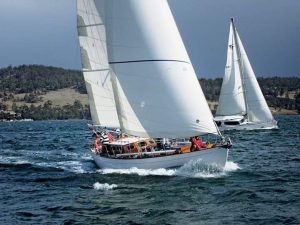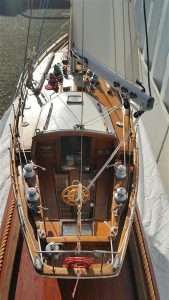The Muir family’s boating history dates back to the 19th century. In the late 1800’s, William Jenkins Muir began working as a seaman. Working mostly between Sydney, New Zealand, and Tasmania, William eventually became the head keeper of Mersey Bluff Lighthouse in Devonport. Passing away in 1929 after over 30 years of working and breathing the sea, William was survived by 14 children, one of whom was Ernest Jenkins Muir. Ernie was born to be a seaman, and Hobart was his playground. He sailed in yacht races, worked on boats, and even survived a shipwreck that included a three-masted schooner and 12 crew. Ernie had five children, all of whom had the same love of the sea running through their veins. Among those five children was Jock Muir. Jock lived up the road at Battery Point in Hobart, placing him right in the action. From a young age, Jock worked on boats and eventually built over 80 yachts and vessels and designed over 100. He is considered as one of the top ten Tasmanians of the 20th century. Among those 80 yachts built is a vessel with quite a history among the Muir family: Trevassa.

Built in 1971, the 48-foot Huon pine yacht Trevassa was returned to the Muir family after 41 years of being owned by yachtsman Russell Duffield. Currently moored at the Royal Yacht Club of Tasmania, Trevassa has sailed in five Sydney-Hobart races. While it has gone under some major refurbishments, the Muir family has kept the boat very similar to the original design. The love and admiration for the Trevassa can be seen in the refurbishments, the participation of Jock’s four children on the process, and especially the current construction of a model replica of the yacht, done by one of Jock’s children, Ross Muir.
Sitting in the parking lot of Muir Chandlery and across the street from Manly Boat Harbour is the shipping container workshop of Ross Muir. Previously featured in the magazine, Ross’ love for all things sailing can be heard in his words, seen on his workshop walls, and felt if one were to take a ride in either of the two timber dinghies he built.
His most recent project is one to be awed. Modeled after the Trevassa, the model version sits at one- meter long, 1/13th of the big boat. “I built it exactly as the big boat – planked it, fiber glassed it, ran ribs inside, 50 ribs on each side,” Ross explained as he removed the deck so he could get a better look at the inside. The entire thing is fitted out: artwork hang on the walls; the saloon has leather couch cushions; a wine rack hangs in the galley; and there is even a binocular rack. LED lights up the interior, letting one really see the intricacies of the model Trevassa. “I must have lifted the deck over a hundred times! You have to make sure things are to scale,” Ross recalled.
The deck of the boat is something of beauty. Made of mostly teak, the inlay and color of the deck look exactly like the big Trevassa. There are hand-carved cleats, and a bilge pump near the companion way. Even the floor of the cockpit is so intricately done and exact. The detailing is magnificent, and the amount of hours and labour put into this model really shows: “700 hours, 5 months fulltime every day. It has been a challenge. Like the windows – I’ve never done anything like it before. I’ve done them on big boats but nothing miniature.”
Why this project? Ross said it was “something to do this year” until he heads back to Hobart in October for the opening of the yachting season. Before he leaves though he will be sending the model Trevassa down south, “[I’ll] send it down on freight. I might exhibit it at the Royal Yacht Club down there. It needs to be seen.” That it does.
The model Trevassa pays homage to Jock Muir but also to Ross Muir’s boat-building history and the Muir family’s adoration with the sea. Ross has worked on the big boat plenty. “We took all the winches off and re-chromed them, took the mast down and put a radar on and wind speed, painted the spars. The boat was in good condition with only one owner, but it was tired. He looked after it well for us, and was glad to see it back in the family where it was built.”
By Sarah Schwaner
(Published in the Oct-Dec 2019 edition)




























